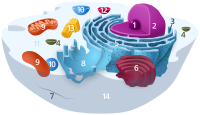
Photo from wikipedia
Intermediate filaments (IFs) are involved in key cellular functions including polarization, migration, and protection against large deformations. These functions are related to their remarkable ability to extend without breaking, a… Click to show full abstract
Intermediate filaments (IFs) are involved in key cellular functions including polarization, migration, and protection against large deformations. These functions are related to their remarkable ability to extend without breaking, a capacity that should be determined by the molecular organization of subunits within filaments. However, this structure-mechanics relationship remains poorly understood at the molecular level. Here, using super-resolution microscopy (SRM), we show that vimentin filaments exhibit a ~49-nanometer axial repeat both in cells and in vitro. As unit-length filaments (ULFs) were measured at ~59 nanometers, this demonstrates a partial overlap of ULFs during filament assembly. Using an SRM-compatible stretching device, we also provide evidence that the extensibility of vimentin is due to the unfolding of its subunits and not to their sliding, thus establishing a direct link between the structural organization and its mechanical properties. Overall, our results pave the way for future studies of IF assembly, mechanical, and structural properties in cells.
Journal Title: Science Advances
Year Published: 2022
Link to full text (if available)
Share on Social Media: Sign Up to like & get
recommendations!